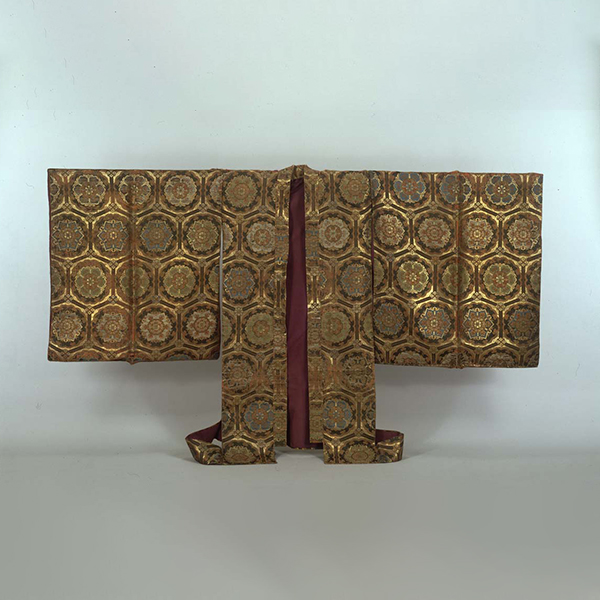能と歌舞伎 能装束に見る舶来の染織
-

法被 金地蜀江模様
中国 奈良・金春家伝来 江戸時代・18世紀本館 9室
2025年8月26日(火) ~ 2025年10月13日(月・祝)「豪華絢爛」ということばでその華やかさが形容される能装束ですが、日本で織られた織物で仕立てられるようになったのは、京都・西陣の織物技術が発達した江戸時代に入ってからのことです。能が観阿弥・世阿弥によって大成され足利将軍家によって庇護されていた室町時代には、まだ、日本に金襴や緞子といった高級織物を織る技術が備わっていませんでした。そのため、中国から舶載された輸入織物が珍重されたのです。
能に用いられる舶来の織物には、その時代の織物の特徴を色濃く示しています。緯糸に木綿を用いる黄緞という錦は、室町時代後期に日本に輸入されます。特に能装束に愛用されましたが、江戸時代以降はほとんど見られることのない特殊な錦となっています。また、荘重で重厚な蜀江文錦は中国・明代を代表する錦でしたが、神性を表わすもっとも格式のある文様として、江戸時代以降も翁狩衣や神々を演じる法被などに用いられてきました。このような舶来織物は、経済力を持つ武将などの権力者しか手に入れることができない高級品でした。特に中世の能装束には中国や朝鮮の卓越した技術で織られた舶載品が用いられており、当時の権力者が高価な織物を能に用いることを重視していたことがうかがえます。
| 指定 | 名称 | 員数 | 作者・出土・伝来 | 時代・年代世紀 | 所蔵者・寄贈者・列品番号 | 備考 | |
| おすすめ | 紫地向鳳凰丸文様金襴 二人静金襴 | 1枚 | 中国 前田家伝来 | 明時代・14~15世紀 | TI-190-16 | ||
| 縞地宝尽文様金襴 金春金襴 | 1枚 | 中国 前田家伝来 | 明時代・16~17世紀 | TI-190-8 | |||
| 茶地龍入輪繋文金襴 逢坂蜀江錦写 | 1枚 | 伊万里 中国 前田家伝来 | 明時代・16世紀 | TI-453-43 | |||
| おすすめ | 重文 | 法被 茶地雲龍模様黄緞 | 1領 | 中国 | 室町~安土桃山時代・16世紀 | 岐阜・春日神社蔵 | |
| おすすめ | 重文 | 狩衣 赤地獣花模様黄緞 | 1領 | 中国 | 室町~安土桃山時代・16世紀 | 岐阜・春日神社蔵 | |
| 側次 浅葱地菊蓮鳳凰模様銀襴 | 1領 | 中国 奈良・金春家伝来 | 安土桃山時代・16世紀 | I-3259 | |||
| おすすめ | 法被 金地蜀江模様錦 | 1領 | 中国 奈良・金春家伝来 | 江戸時代・18世紀 | I-3255 | ||
| おすすめ | 長絹 紺地牡丹唐草蝶鳥模様紋紗 | 1領 | 朝鮮 上杉家伝来 | 江戸時代・18世紀 | I-2836 | ||
| 狩衣 紺地牡丹唐草模様紋紗 | 1領 | 朝鮮 上杉家伝来 | 江戸時代・18世紀 | I-2841 |
